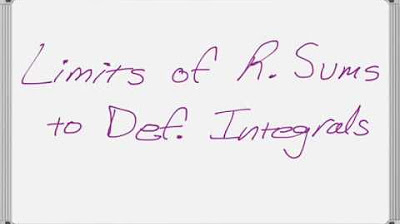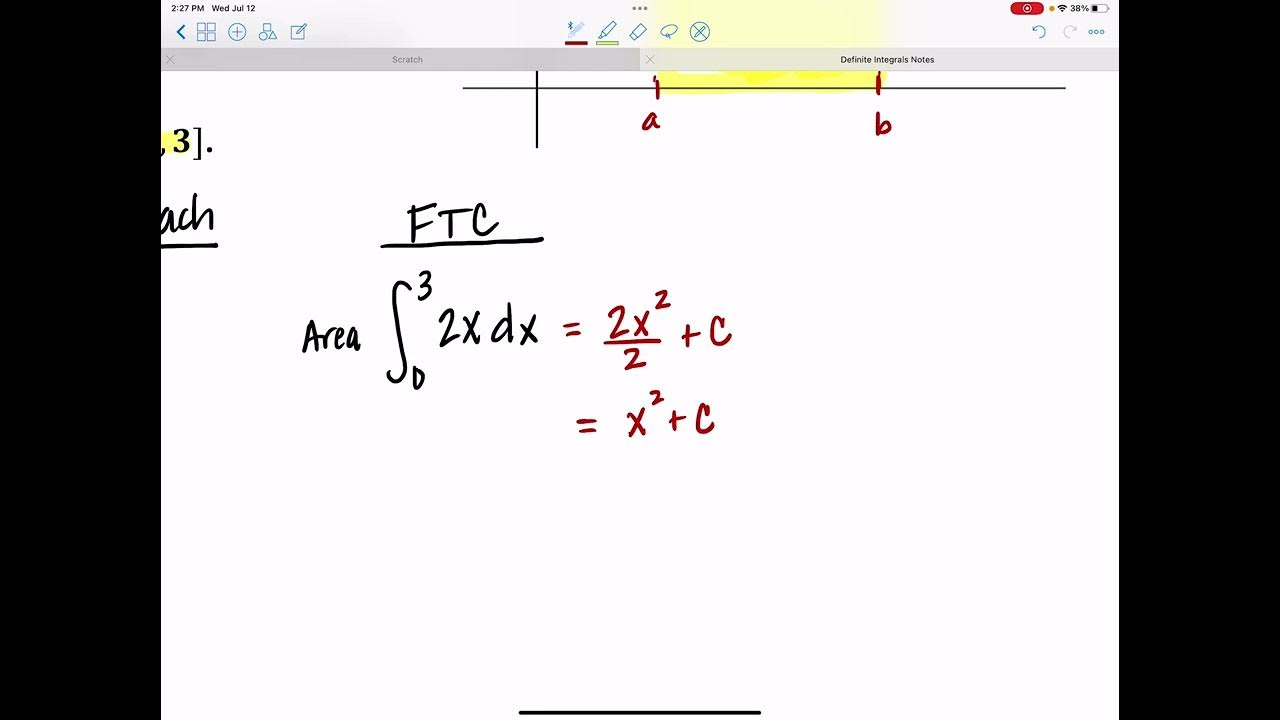Switching bounds of definite integral | AP Calculus AB | Khan Academy
TLDRThe video script discusses the concept of definite integrals and their geometric interpretation as the area under a curve. It explains how to approximate this area by dividing the curve into rectangles with equal width, represented by delta x, calculated as (b-a)/n. The script then explores the effect of reversing the bounds of integration, highlighting that it results in the negative of the integral from a to b. This property is crucial for understanding and solving integrals.
Takeaways
- 📌 The definite integral is represented by the area under a curve (shaded in blue) from point a to b.
- 📈 This area can be approximated by dividing it into n rectangles with equal width, denoted as delta x.
- 🤔 The width of each rectangle, delta x, is calculated by (b - a) / n, where n is the number of rectangles.
- 🏢 The approximation of the integral becomes more accurate as n increases, which is the concept of a Riemann sum.
- 🎯 The exact value of the definite integral is found in the limit as n approaches infinity, with delta x approaching 0.
- 🔄 If the bounds of integration are swapped, the result of the integral will be the negative of the original integral.
- 🌀 Swapping the integration bounds changes the delta x to its negative, resulting in the negative of the integral value.
- 📚 Understanding this property is crucial for making sense of integrals and solving them.
- 🧠 The concept is rooted in the fundamental idea of dividing the area under the curve into smaller, manageable parts.
- 🔢 The process of integration is essentially summing the areas of these infinitesimally small rectangles as n grows larger.
- 📈 This method of integration is a foundational concept in calculus and is used to solve a variety of mathematical problems.
Q & A
What is the basic concept of a definite integral?
-The definite integral from a to b of a function f(x)dx represents the signed area under the curve of the function between the limits a and b.
How can we approximate the definite integral using rectangles?
-We can approximate the definite integral by dividing the area under the curve into n equal rectangles, each with a width of delta x, and a height equal to the function value at a specific point within the rectangle.
What is the formula to calculate delta x when dividing the area under the curve into n rectangles?
-The formula to calculate delta x is (b - a) / n, where b and a are the upper and lower limits of integration, respectively, and n is the number of rectangles.
What is the significance of the limit as n approaches infinity in the definition of a definite integral?
-The limit as n approaches infinity represents the process of making the width of the rectangles approach zero, which leads to a more accurate approximation of the area under the curve, eventually reaching the true value of the definite integral.
How does changing the order of the integration limits from a to b to b to a affect the integral?
-Changing the order of the integration limits from a to b to b to a results in the negative of the original integral because the delta x becomes negative, leading to the integral being the negative of the integral from a to b.
What is the Riemann sum and how does it relate to the concept of definite integrals?
-The Riemann sum is a method to approximate the definite integral by summing the areas of rectangles constructed under the curve of the function over the interval. It is directly related to the definition of a definite integral, as the limit of these Riemann sums as the number of rectangles approaches infinity gives the exact value of the integral.
Why is the property of changing the order of integration limits important?
-This property is important because it provides a fundamental understanding of how the definite integral behaves under different conditions, and it can simplify the process of evaluating certain integrals by recognizing when the integral can be transformed to a more manageable form.
What is the relationship between the width of the rectangles (delta x) and the number of rectangles (n)?
-The width of the rectangles (delta x) is inversely proportional to the number of rectangles (n). As the number of rectangles increases, the width of each rectangle decreases, leading to a more precise approximation of the area under the curve.
How does the height of each rectangle in the approximation of the integral get determined?
-The height of each rectangle is determined by the function value at a specific point within the rectangle, denoted as x sub i, which is used to calculate the area of each rectangle.
What is the significance of the function value (f of x sub i) in calculating the area of each rectangle?
-The function value (f of x sub i) determines the height of each rectangle, which is essential for calculating the area of the rectangle. This value directly influences the size of the individual areas and, consequently, the total approximation of the integral.
In the context of the script, why is the concept of negative delta x important?
-The concept of negative delta x is important because it reflects the change in the direction of the interval when the order of integration limits is reversed. This change in direction results in the integral value being negated, which is a key property when dealing with integrals and their transformations.
Outlines
📐 Understanding Definite Integrals and Rectangle Approximations
This paragraph introduces the concept of definite integrals and their visual representation as the area under a curve. It explains how to approximate this area by dividing it into rectangles with equal width, each representing a small portion of the curve. The process of calculating the width (delta x) is described, which involves dividing the total length (b minus a) by the number of rectangles (n). The paragraph then discusses how the area under the curve can be approximated by summing the areas of these rectangles, with each rectangle's area calculated by multiplying the function's value at a specific point (x sub i) by delta x. The concept of Riemann sums is briefly mentioned, and the idea of taking the limit as n approaches infinity to find the exact area of the definite integral is introduced. The paragraph concludes by encouraging the viewer to reflect on how changing the order of the integration bounds from a to b to b to a affects the calculation and leads to a negative result, highlighting an important property of integration.
Mindmap
Keywords
💡Definite Integral
💡Approximation
💡Rectangles
💡Delta X
💡Summation
💡Limits
💡Integration Property
💡Riemann Sums
💡Function Value
💡Negative Delta X
💡Infinite Sum
Highlights
The definite integral is introduced as the area shaded in blue.
The area under a curve can be approximated by dividing it into n rectangles.
The width of each rectangle is assumed to be the same for simplicity.
The width of each rectangle, delta x, is calculated by (b - a) / n.
The approximation of the integral is the sum of the areas of the rectangles.
The height of each rectangle is determined by the function value at a specific point, f(x_i).
The area of each rectangle is found by multiplying the height, f(x_i), by delta x.
The Riemann sum is used to approximate the integral using the areas of the rectangles.
The exact value of the integral is the limit as n approaches infinity of the Riemann sum.
Swapping the bounds of integration results in a change from b - a to a - b.
The delta x becomes the negative of the original delta x when the bounds are swapped.
The integral from b to a is equal to the negative of the integral from a to b.
This property is crucial for understanding and solving certain integrals.
The concept of definite integrals and their approximation is foundational in calculus.
The method of using rectangles to approximate areas is known as the Riemann sum approach.
Understanding the impact of changing the order of integration bounds is essential for advanced calculus topics.
The transcript provides a clear and detailed explanation of the process of integration and its properties.
Transcripts
Browse More Related Video

Integrating scaled version of function | AP Calculus AB | Khan Academy

Riemann sums in summation notation | Accumulation and Riemann sums | AP Calculus AB | Khan Academy

Writing Definite Integrals from Limits of Riemann Sums

Definite Integrals

AP Calculus AB: Lesson 6.2 Part 2 (Limit Definition of Definite Integral)

Definite Integrals!
5.0 / 5 (0 votes)
Thanks for rating: